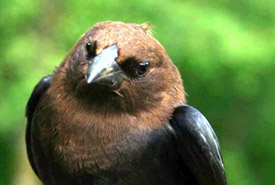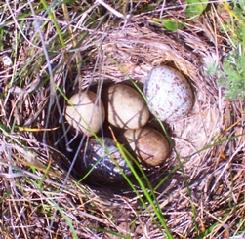
Brown-headed cowbird (Photo by Stephen Davis)
Brown-headed cowbird
Range and habitat
The brown-headed cowbird is a blackbird found in nearly all of Canada, near livestock, birdfeeders and forest edges.
In Alberta, this species is found throughout most areas of the province and has been observed on the Nature Conservancy of Canada's (NCC's) Stewart and Johnson properties in the Milk River Ridge Natural Area, the Horseshoe Canyon Property, and the Gray Property in the Cooking Lake Moraine Natural Area.
A crafty mother
The brown-headed cowbird is very similar to other birds, except in its nesting habits.
Most birds build a nest, lay eggs, incubate them and care for their chicks. The brown-headed cowbird on the other hand has a different strategy. Somehow this crafty bird manages to outsource all the work!
What is brood parasitism?
The brown-headed cowbird is a brood parasite. A parasite is generally defined as an organism that lives on or in another and benefits from it in a detrimental way.
The brown-headed cowbird parasitizes the nests, or broods, of other birds. She will perch herself up high and observe other birds building nests or tending to an existing nest. The cowbird will sneak in when the other bird is away from her nest and lay one of her own eggs.
The goal of the female cowbird is to lay as many eggs as possible during the breeding season (May to July). During that time she will lay nearly one a day up to 30 or 40 eggs in one season. Even though their light-blue speckled eggs look different from many other birds' eggs, cowbirds' eggs are usually accepted by the mother or host bird. Some birds recognize the egg as an impostor and either remove it or abandon the nest, but in most cases they accept it as their own.

Horned lark nest with brown-headed cowbird eggs (Photo by NCC)
A successful strategy
Brown-headed cowbird chicks have an advantage over the host bird's chicks for several reasons. The egg hatches earlier than many other species' eggs and once hatched, the chick tends to grow rapidly. This makes them larger and more aggressive, thus allowing them to reach the highest and get the most food.
As a result, the host bird usually fails to raise any of its own young during that season. However, in later years, some birds learn to push out the impostor egg, or build a second layer in the nest, burying the brown-headed cowbird egg. There are many bird species that have not developed these coping strategies yet and this comes at a price to their own offspring.
Another reason for the success of brown-headed cowbirds is that they are not picky about where they leave their eggs. They have been known to lay eggs in the nests of more than 200 species of birds. Of that number, more than 150 bird species have been known to successfully raise brown-headed cowbird chicks. Common host birds in Canada include yellow warbler, song sparrow and chipping sparrow.
How did this happen?
It is easy to critique the reproductive habits of the brown-headed cowbird, but consider the history of their behaviour first: the brown-headed cowbird, a native species to North America, used to be known as the "Buffalobird" because the species would follow herds of plains bison that roamed the grasslands. The bison would disturb insects in the ground, exposing a plentiful food supply for the brown-headed cowbird population. The birds could not stop to nest or they would lose this food supply. The solution for their species survival was to lay a single egg in the nests of other birds in the course of their travels.
This evolutionary strategy has obviously proven successful and allowed brown-headed cowbirds to thrive. As wild herds of plains bison no longer roam the prairies of North America, the brown-headed cowbird has successfully transitioned to living near herds of cattle. You can even see them perched on the backs of cows.





